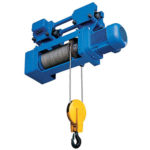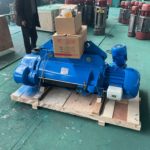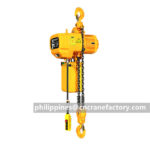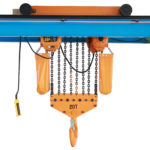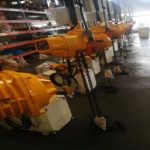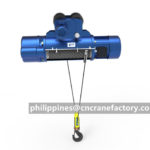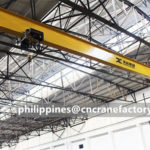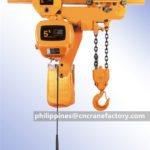Overhead cranes offer a safe and efficient way to transport materials or product from one point to another in a facility, workshop or warehouse where loads are heavy—typically measured in tonnage. While structurally, the runway and bridge rails of a crane provide the framework for the mechanism, it is the hoist who’s job it is to do the actual moving and lifting. No small job! Overhead cranes are installed near the ceiling of a facility for optimum clearance and the hoist lowers a hook from a chain or wire rope to pick up the load. Hoists glide along the length of a crane girder or it straddles two in heavier duty cases, either along the top (called top running) or attached to the bottom I-beam(s) if overhead space is limited (called under running). The hoist lifts objects secured onto the attached hook by chain, a woven fabric or wire rope sling or by one of several types of below-the-hook devices such as a spreader beam that serves to evenly distribute the weight of a load.
What is a Hoist?
A hoist is a mechanical device, manually, electrically, or pneumatically powered, that is used for vertical lifting, lowering or moving an object along a horizontal path. Lifting is accomplished when a wire rope or chain winds or unwinds as the hoist drum rotates. Hoists are controlled by an overhead crane operator via an attached electrical push button pendant device or can be radio controlled, remotely. A wide variety of industries use hoists in their daily business operations, such as Aerospace, Agriculture, Automotive, Computer, Construction, Chemical, Food, Logging, Marine, Manufacturing, Medical, Mining, Telecommunication, Transportation, Hospitals, Health care, Entertainment and many others.
There are a few different types of hoists that come with a variety of options such as lift weight, length of chain, lift speed and its configuration is usually defined by the lifting medium, operation and suspension. A hoists’ operation indicates the type of power used to operate the hoisting motion.
TYPES OF HOIST POWER
Manual Hoists
A manual hoist is a hoist that’s operated by hand, mainly used when a power source is not available. The advantage to using a manual hoist is that it’s portable and doesn’t require much headroom for operation. They are simple mechanisms that use chains, a hook or hooks and gears to move a load. They work when an operator pulls down on one of the chain loops on one side of the chain. This turns a pulley and lifts up the end of the other chain which has the hook. There are two types of manual hoists:
- Hand Chain Hoist, which is sometimes called a Chain fall
- Lever Hoist, which is sometimes called a Come along, a Pull or a Ratchet Hoist
You don’t have to be at the point of hookup to operate a hand chain hoist. This comes in handy if the hookup point is a number of feet above the floor. A long pull chain would allow you to operate it from the floor. While manual hoists are mainly used for vertical lifting, the lever hoist also lends itself well to horizontal or diagonal pulls and can be used in any position. The lock on the lever can be released in order to free wheel the chain through to speed up rigging time.
Both the hand chain and lever hoists are easy to use and maintain.
Electric Hoists
Electric hoists vertically lift and lower loads via a mechanized chain or wire rope. Due to their integration within the overhead crane system, they are not meant to be taken from one job site to another and mainly work only in one area. Like the Manual Hoist, the Electric Hoist lifts with chains and gears, a drum, a hook or hooks but also with wire rope and a motor. Many variables should be considered when choosing an electric hoist for your overhead crane, including its specific application and the environment in which it will function. These types of hoists use motors available in a variety of voltages and work duties and may come with useful accessories like a rigid hook, swivel hook, lug, and a push trolley, geared trolleyor motorized trolley allows them to be mounted to a crane, a beam or a gantry. The two types of Electric Hoists are:
- Electric Chain Hoist, where a chain is the medium used to lift and lower a load
- Wire Rope Hoist, where a wire rope is used to lift and lower a load
These hoists can lift, hold and travel with the load pending if they are mounted to a trolley. Electric Hoists need working space and the operator must be able to maintain a safe distance while the hoist is being used.
Pneumatic Hoists
A Pneumatic Hoist, also known as an Air Hoist or Air Powered Hoist, functions much in the same way as an Electric Hoist, except it’s powered by air pumped through a tube into a spin rotor that engages the gears to operate. The special advantage of an air hoist is that it is capable of positioning and placing a load precisely and can move faster than other types of hoists. Pneumatic Hoists are also known as the workhorse of hoists because they are not susceptible to over-heating the way electric hoists are, so they can be used for extended hours, even all day, every day.
The two types of Air Hoists are:
- Air Chain Hoist, where a chain is the medium used to lift and lower a load
- Wire Rope Air Hoist, where a wire rope is used to lift and lower a load
Hoists are one of the most versatile and useful tools available. Whether you use them for rigging a load in the back of your truck or to move massive spools of steel from one side of a warehouse to another or to lift a ship out of a body of water and into a shipyard, you’ll find a trusty hoist in one form or another on the job.
If you need some help picking a hoist for your overhead crane application or have any questions, feel free to contact me!
